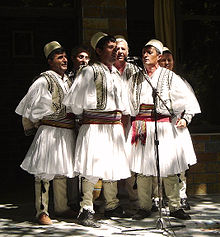Iso-Polyphony
| Iso-Polyphony | |
|---|---|
 A traditional male group performing | |
| Stylistic origins | Albanian music |
| Typical instruments | Human voice |
| Albanian folk iso-polyphony | |
|---|---|
| Country | Albania |
| Reference | 00155 |
| Region | Europe and North America |
| Inscription history | |
| Inscription | 2008 (3rd session) |
| List | Representative |
Iso-Polyphony is a traditional part of Albanian folk music and, as such, is included in UNESCO's intangible cultural heritage list.[1]
All four regions of southern Albania—Lalëria (
Labëria is particular well known for multipart singing; songs can have two, three, or four parts. Two-part songs are sung only by women. Three-part songs can be sung by men and women. Four part songs are a Labërian specialty. Research has shown that four-part songs developed after three-part ones, and that they are the most complex form of polyphonic singing.[3]
The
Geographic distribution
The Albanian polyphonic traditional music is performed in two
Origin
Many scholars who have studied the
Although the region was under the dominion of the Byzantine Empire for many centuries, the Balkan polyphonic traditional music had a different development than medieval Byzantine music. The Balkan tradition was non-institutionalized and has been continually collectively formed, while the Byzantine music was created by individual composers and was institutionalized. The Balkan tradition has been transmitted orally down the generations, and its performers were common people musically illiterate, while the Byzantine music was widely documented, and has been performed by professionals who were trained and educated. The two musical traditions lived side by side for centuries, therefore they would have had a mutual influence on each other. However, it is thought that the interaction between the Albanian polyphonic traditional music and the Byzantine music has been relatively small.[7]
Evolution
Albanian polyphonic traditional music is thought to have been composed in its beginnings of only two melodic lines: the taker (
The next melodic line to evolve into Albanian traditional polyphony is thought to have been the drone (
The last melodic line to evolve into Albanian traditional polyphony was the launcher (
Pleqërishte
Pleqërishte is a genre of Albanian folk iso-polyphony sung by men in Labëria and is principally identified with the city of Gjirokastër and its environs. The genre is characterized by a slow tempo, low pitch and small range.
Pleqërishte means both "of old men" and "of the old time" in reference to the mode of singing and the lyrical themes of part of their songs respectively. In relation to these subjects pleqërishte songs are also called lashtërishte ("of the ancient time"), a term used exclusively in Gjirokastër.[15] These specific topics have largely fallen into public disuse over the years but remain thematically notable.
Songs of the genre adhere to a slow tempo and low pitch with little vocal variation as opposed to genres such as djemurishte ("of young men") in particular.[16] As all fourth-part genres they feature a third soloist (hedhës). While in other four-part genres the hedhës mainly assumes the role of secondary drone a minor third above the keynote, in pleqërishte the hedhës relieves the first soloist (marrës) and allows him to take a breathing break.[15] Each rendition begins with the singing of the first lines by the marrës and the introduction of the second soloist (kthyes) and finally the hedhës. After the hedhës, the marrës's lyrics are repeated by the drone group in various forms and manners.
Pleqërishte songs are exemplified in the repertory of the folk group Pleqtë e Gjirokastrës sometimes regarded as the "last representative" of the genre.[15][17] One of the best-known songs of the genre and most notable renditions of the group is Doli shkurti, hyri marsi, which details a battle between Çerçiz Topulli and Ottoman troops in 1908 in the village of Mashkullorë near Gjirokastër.
See also
References
Citations
- ^ "UNESCO Culture Sector - Intangible Heritage - 2003 Convention". Unesco.org. Retrieved 2013-09-22.
- ISBN 9783205780908.
- ^ Ahmedaja, Haid (2008), p.214-215
- ^ Ahmedaja, Haid (2008), p.241
- ^ a b c Shetuni 2011, p. 34.
- ^ Stipčević 1989, pp. 189–190.
- ^ a b c Shetuni 2011, pp. 33–34.
- ^ Tole 2014, p. 166.
- ^ Tole 2014, p. 105-106.
- ^ a b Tole 2014, p. 106-107.
- ^ Shetuni 2011, pp. 34–35.
- ^ a b Tole 2014, p. 107-109.
- ^ Tole 2014, p. 100.
- ^ a b Shetuni 2011, p. 35.
- ^ ISBN 9783205780908. Retrieved 1 March 2013.
- ^ Stockmann, Doris; Erich Stockmann (1963). "Die vokale Mehrstimmigkeit in Süd-Albanien". Les Colloques de Wegimont. 171. Cercle Internationale d'Études Ethno-musicologiques: 104.
- ^ Tole, Vasil. "Inventory of performers on iso-polyphony" (PDF). UNESCO. p. 121. Retrieved 1 March 2012.
Literature
- Tole, Vasil (2014), Enciklopedia e iso-polifonisë popullore shqiptare (in Albanian)
Bibliography
- Shetuni, Spiro J. (2011). Albanian Traditional Music: An Introduction, with Sheet Music and Lyrics for 48 Songs. McFarland. ISBN 978-0-7864-8630-4.
- ISBN 9788603991062.
External links
Pleqërishte
- Doli shkurti, hyri marsi on YouTubeby Pleqtë e Gjirokastrës
- Leshverdha drrullë on YouTubeby Pleqtë e Gjirokastrës

